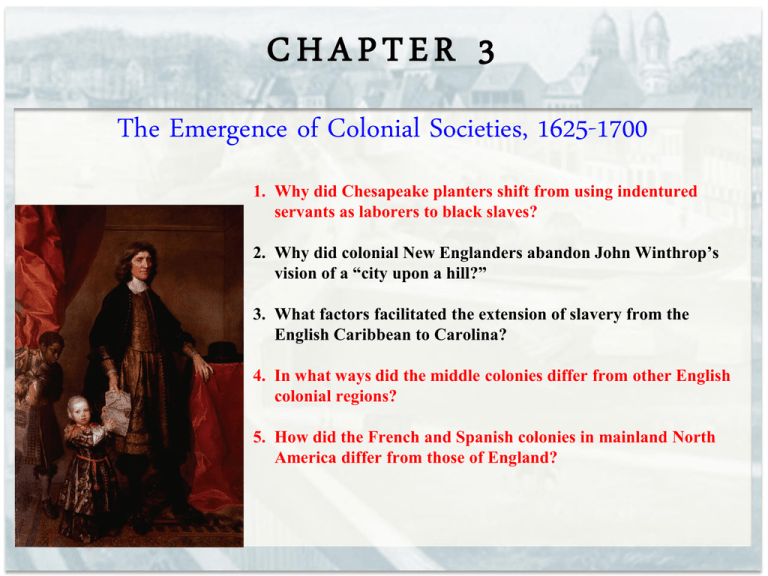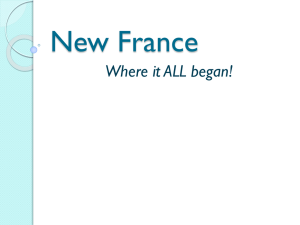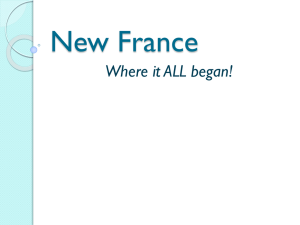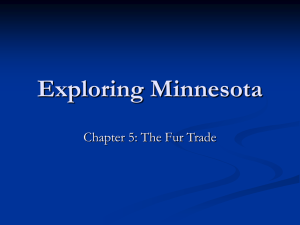Regular PowerPoint - Bremerton School District
advertisement

CHAPTER 3 The Emergence of Colonial Societies, 1625-1700 1. Why did Chesapeake planters shift from using indentured servants as laborers to black slaves? 2. Why did colonial New Englanders abandon John Winthrop’s vision of a “city upon a hill?” 3. What factors facilitated the extension of slavery from the English Caribbean to Carolina? 4. In what ways did the middle colonies differ from other English colonial regions? 5. How did the French and Spanish colonies in mainland North America differ from those of England? Chesapeake Society State and Church in Virginia Virginia House of Burgesses: Royal Governor’s Council: Anglican Church: POLITICAL Elected by landowners Appointed by the crown RELIGIOUS Established church of Virginia, but not as much of daily life as it was in England ROYAL COLONY Chesapeake Society State and Church in Maryland Lord Baltimore (Cecilius Calvert): Proprietor of Maryland • Wanted to make Maryland a haven for Catholics • But… too many Protestants moved in Act of Religious Toleration (1649): • Protected the Catholics • Protestants repealed it in 1654 PROPRIETARY COLONY Chesapeake Society Death, Gender, and Kinship 90% of Chesapeake immigrants were indentured servants 80% of indentured servants were male So… it was very advantageous to be a lady! Hard work and disease (typhoid and malaria) kept life expectancy in the Chesapeake (mid 40s) a little lower than England and about 20 years lower than New England! The Chesapeake at this time had a negative population growth Chesapeake Society Tobacco Shapes a Region, 1630-1675 Few neighbors: 6 people per mi2 Kitsap County: 610 people per mi2 Lived by rivers (good soil and transportation) Due to headrights, some planters became very wealthy by using (abusing?) their indentured servants on their large plantations Even after freed, there wasn’t much to look forward to for an indentured servant The rich got richer and the poor stayed poor Chesapeake Society Bacon’s Rebellion, 1676 Racist Virginia farmers were tired of not having access to good land (due to local Indians and govt. policies) and the worsening economy Behind Nathaniel Bacon, (and Governor Berkeley’s permission), they brutally killed peaceful Indians Berkeley called back the movement, so Bacon and his boys burned Jamestown in defiance When Bacon died that year, so did the movement Chesapeake Society From Servitude to Slavery THREE STAGES OF SLAVERY 1619-1640: Blacks and Indians treated mostly like indentured servants 1640-1660: Slavery became a lifelong condition 1660 & beyond: Racial slavery was fully legalized • • • • Why did slavery replace indentured servitude? Life got better in England = not as many indentured servant immigrants More slave trading companies came into existence Wealthy planters wanted to avoid conflict with poor white laborers (they didn’t want another Bacon’s Rebellion) Sheer and utter racism Puritanism in New England A City Upon a Hill Massachusetts Bay Colony (just North of Plymouth) John Winthrop led about 700 Puritans to create a CITY UPON A HILL (from his sermon entitled, “A Model of Christian Charity”) MCB was more stable than the Chesapeake due to a focus on the family rather than solely on capitalism All you needed to vote was to be a male member of the church – no property requirements. SELF-GOVERNING COLONY Puritanism in New England New England Ways The Conversion Experience: Education: A public account of your conversion (very intense, a lot of grilling by the ministers) Had to be able to read the Bible 50 Households = 1 Teacher 100 Households = 1 School Harvard College founded 1636 The established church was mandatory in both attendance and tax support Puritanism in New England New England Ways Roger Williams Minister who believed in total separation between church and state (so the state wouldn’t corrupt the church Banished in 1635 – bought land from nearby Indians and called it Providence, which later became Rhode Island Anne Hutchinson A woman layperson who criticized the ministers for being too Catholic-like She knew her scriptures really well and said only 2 ministers were legit Banished – went to Rhode Island Puritanism in New England Towns, Families, and Farm Life Politics = Town Meeting Clustered towns (unlike in Chesapeake) Life expectancy = mid 60s due to better diet and a lot less disease (20 yrs. higher than in Chesapeake) Rapid population growth due to families, not immigration Very male-centric society Puritanism in New England Economic and Religious Tensions Over time New England became more isolated, individualistic, and materialistic The church came up with the HALFWAY COVENANT to make sure that they didn’t eliminate all their “saints” The city upon a hill and spiritual purity was losing the fight against money and worldly power Puritanism in New England Expansion and Native Americans Pequot War (1637) Colonists sadistically attacked Indians (many of them were unarmed) and paved the way for expansion into Connecticut New England Indian population decreased dramatically, as did the beaver population = debt = sold their lands = changed the entire ecosystem of New England Many Indians turned to alcohol or reservation life in “praying towns” Puritanism in New England Expansion and Native Americans King Philip’s War (1675-1676) Reduced New England’s Indian population by 40% Ended organized resistance to white expansion in New England Increased white hostility towards all New England Indians Made life even worse for New England Indians Puritanism in New England Salem Witchcraft, 1691-1693 WHAT CAUSED THE WITCH HUNT??? MONEY JEALOUSY GIRLS JUST WANNA HAVE FUN! The DEVIL ERGOT POWER The Spread of Slavery: The Caribbean and Carolina Sugar and Slaves: The West Indies 1640: Sugar replaced tobacco as the main commercial crop in the Caribbean Sugar = more black slave labor This made England filthy rich and the Caribbean a slave society Eventually folks migrated to Carolina The Spread of Slavery: The Caribbean and Carolina Rice and Slaves: Carolina Northern = Tobacco, lumber, pitch Southern = Rice (starting 1690s) Rice = more black slave labor due to immunity from malaria and a background knowledge of rice They used Indian slaves, too Rice growers became very wealthy Carolina was the only British mainland colony with an African majority PROPRIETARY COLONY The Middle Colonies Precursors: New Netherland and New Sweden New Netherlands and their Iroquois Allies displaced many of the Huron (French allies) during the “beaver wars” of 1648-1657 New Netherlands annexed New Sweden in 1655 The Middle Colonies English Conquests: New York and New Jersey England seized control of New Netherlands in 1664 and created New York and New Jersey as proprietary colonies A few rich patroons got even richer in New York New Jersey was a mess from the start New York became a royal colony in 1685 New Jersey became a royal colony in 1702 ROYALCOLONIES COLONIES PROPRIETARY The Middle Colonies Quaker Pennsylvania Quakers • • • • Society of Friends Believed in direct intervention with God No need for clergy Treated all (rich/poor, men/women, English/Native American) equally • Opposed any type of hierarchy (viewed by many at the time as disrespectful) • Opposed war The Middle Colonies Quaker Pennsylvania William Penn was given the land from King Charles II to pay off a family debt He wanted to create a colony based on Quaker ideals Pennsylvania was religiously tolerant, had a legislative assembly, and treated the Indians with respect The colony was well-planned, however, some still didn’t like paying rent and in 1704 created a separate colony of Delaware PROPRIETARY COLONY Rivals for North America: France and Spain France Claims a Continent • • • • • • Missionaries Good Indian relations Fur fur fur fur fur fur fur Fur fur fur fur fur fur fur Fur fur fur fur fur fur fur Fur fur fur fur fur fur fur Rivals for North America: France and Spain New Mexico: The Pueblo Revolt 1680: Pueblo Indians fought back against Spanish rule 1700: The Spanish reestablished New Mexico (without the forced labor and Catholic conversions) = better Spanish-Indian relations Rivals for North America: France and Spain Florida and Texas Florida was a mess for the Spanish • Natives resisted their rule • Native allies were captured and taken away (by English) • English were to the North • French were to the West • Established the province of Texas (Tejas) in 1691, but nobody settled there until 1716








